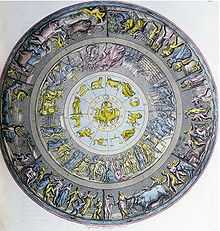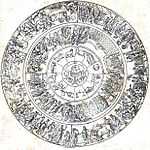Shield of Achilles

The Shield of Achilles is the shield that Achilles uses in his fight with Hector, famously described in a passage in Book 18, lines 478–608 of Homer's Iliad.
In the poem, Achilles has lost his armour after lending it to his companion Patroclus. Patroclus has been killed in battle by Hector and his weapons taken as spoils. Achilles' mother Thetis asks the god Hephaestus to provide replacement armour for her son.
The passage describing the shield is an early example of ekphrasis (a literary description of a work of visual art) and influenced many later poems, including the Shield of Heracles once attributed to Hesiod.[1] Virgil's description of the shield of Aeneas in Book Eight of the Aeneid is clearly modelled on Homer. The poem The Shield of Achilles (1952) by W. H. Auden reimagines Homer's description in 20th century terms.
Description

Homer gives a detailed description of the imagery which decorates the new shield. Starting from the shield's centre and moving outward, circle layer by circle layer, the shield is laid out as follows:
- The Earth, sky and sea, the sun, the moon and the constellations (484–89)
- "Two beautiful cities full of people": in one a wedding and a law case are taking place (490–508); the other city is besieged by one feuding army and the shield shows an ambush and a battle (509–40).
- A field being ploughed for the third time (541–49).
- A king's estate where the harvest is being reaped (550–60).
- A vineyard with grape pickers (561–72).
- A "herd of straight-horned cattle"; the lead bull has been attacked by a pair of savage lions which the herdsmen and their dogs are trying to beat off (573–86).
- A picture of a sheep farm (587–89).
- A dancing-floor where young men and women are dancing (590–606).
- The great stream of Ocean (607–609).[2]
Interpretation
The Shield of Achilles can be read in a variety of different ways. One interpretation is that the shield is simply a physical encapsulation of the entire world. The shield’s layers are a series of contrasts – i.e. war and peace, work and festival, although the presence of a murder in the city at peace suggests that man is never fully free of conflict. Wolfgang Schadewaldt, a German writer, argues that these intersecting antitheses show the basic forms of a civilized, essentially orderly life.[3] This contrast is also seen as a way of making “us…see [war] in relation to peace.[4]" The shield’s description falls between the fight over Patroclus’ body and Achilles’ reentry into battle, the latter being the impetus to one of the poem’s bloodiest parts. Consequently, the shield could be read as a “calm before an impending doom,” used to emphasize the brutality of violence during the Trojan War. It could also be read as a reminder to the reader of what will be lost once Troy ultimately falls.[5]
References
- ↑ The Oxford Companion to Classical Literature (1989 ed.) p.519
- ↑ Homer, The Iliad trans. E.V. Rieu (Penguin Classics, 1950) pp.349–53
- ↑ Wolfgang Schadewaldt, “Der Schild des Achilleus,” Von Homers Welt und Werk (Stuttgart 1959).
- ↑ Oliver Taplin, “The Shield of Achilles within the Iliad,” G&R 27 (1980) 15.
- ↑ Stephen Scully, “Reading the Shield of Achilles: Terror, Anger, Delight,” Harvard Studies in Classical Philology, Vol. 101. (2003), pp. 29–47.
External links
| Wikisource has original text related to this article: |
| Wikisource has original text related to this article: |